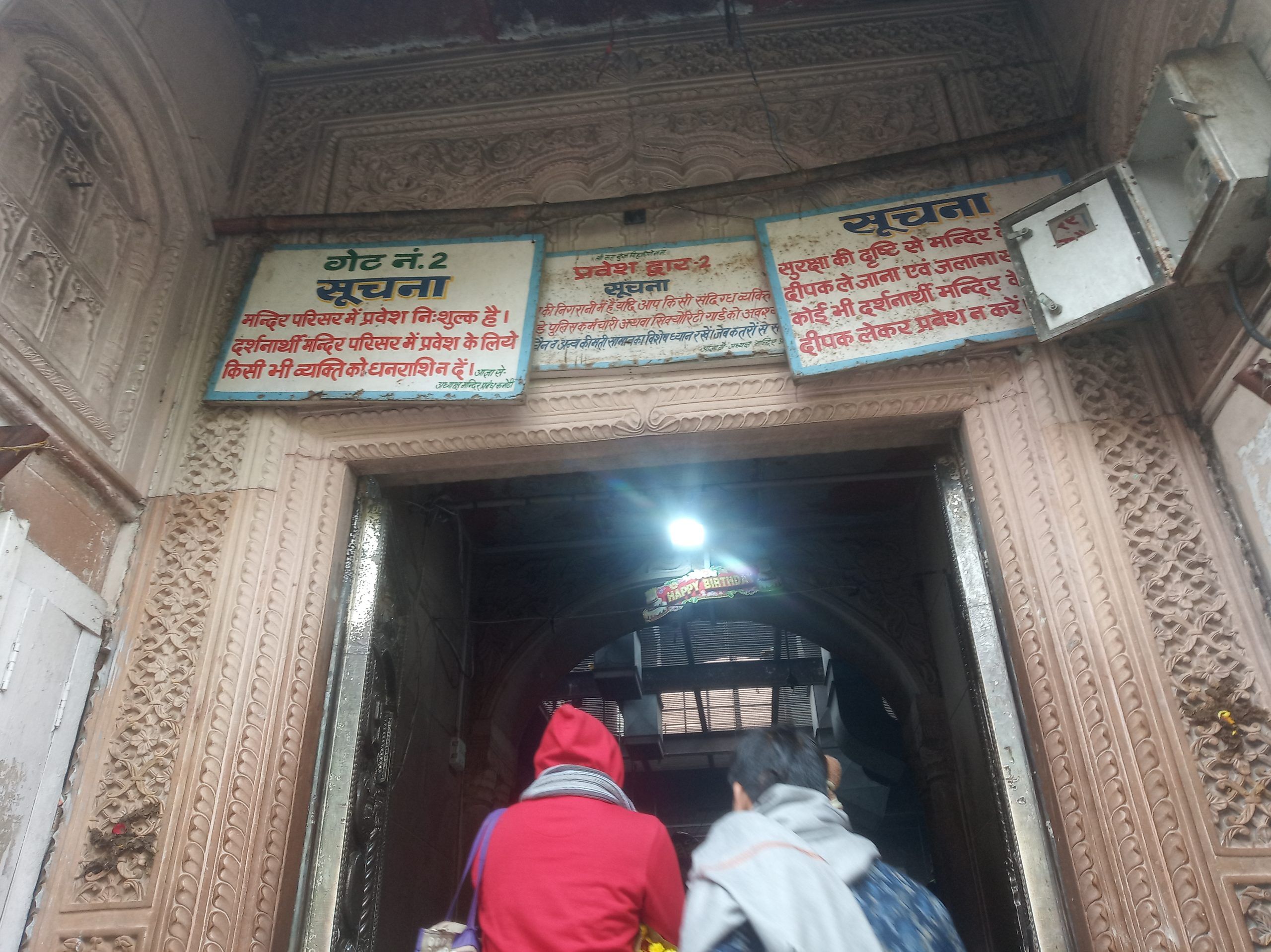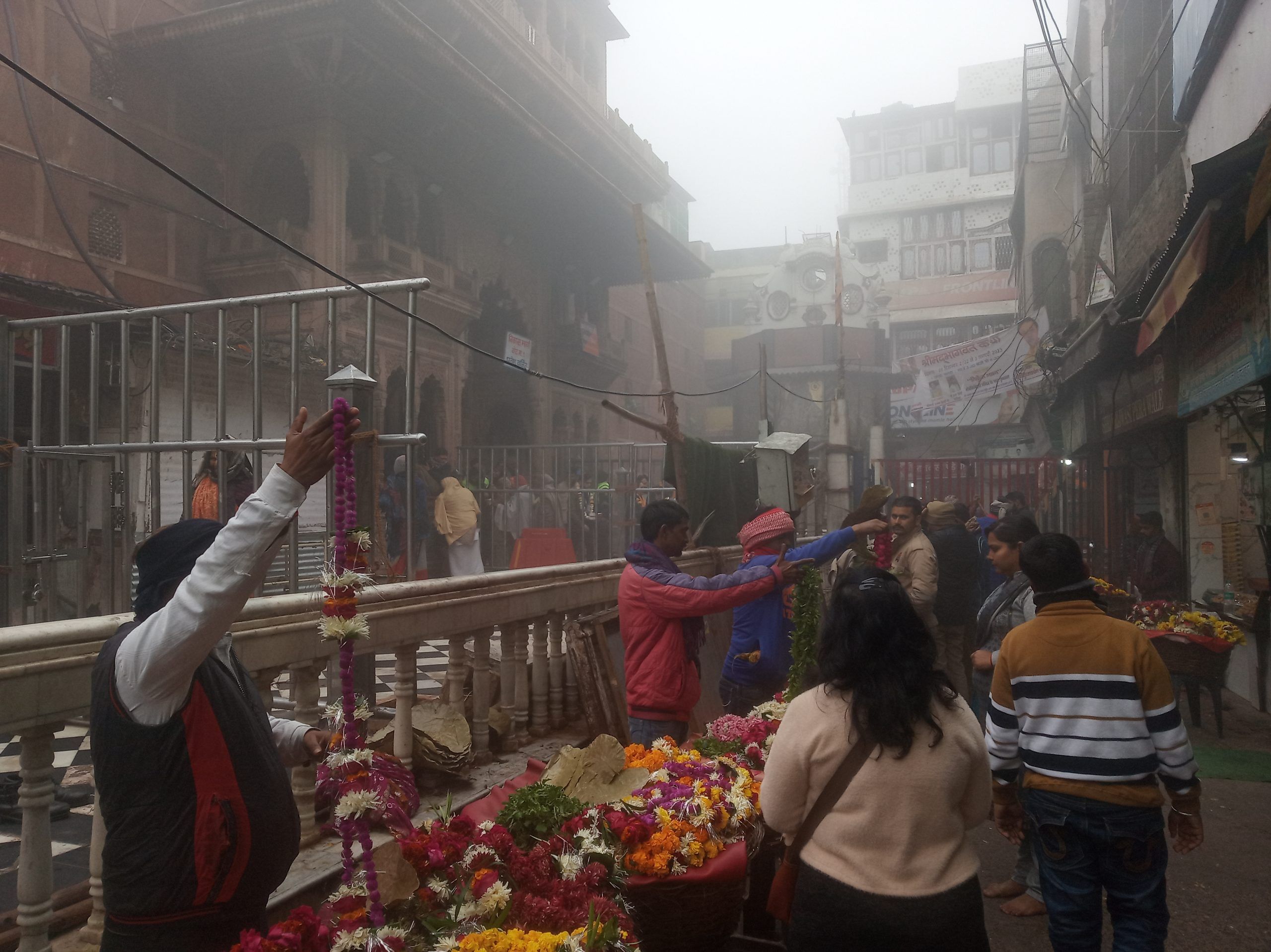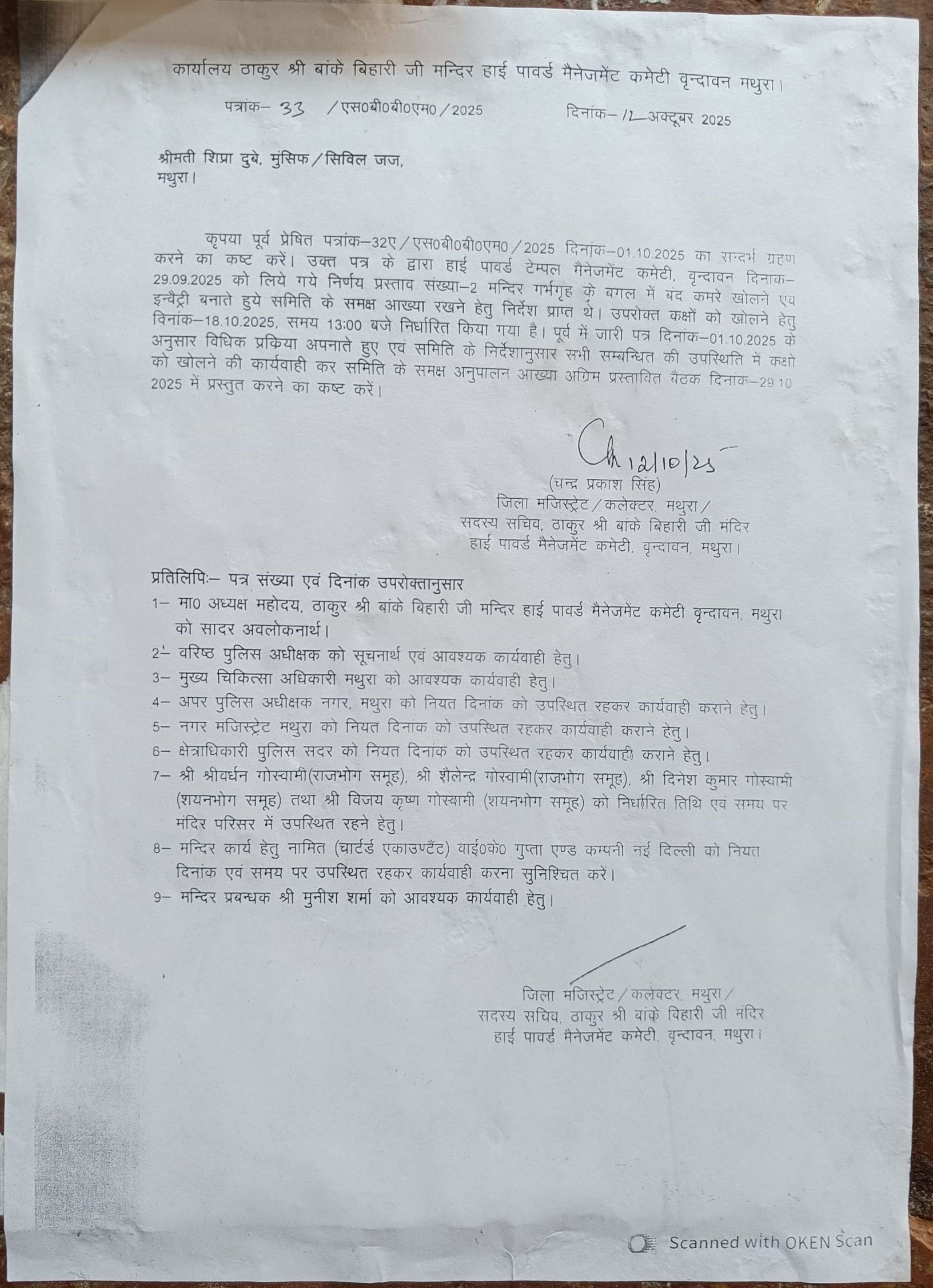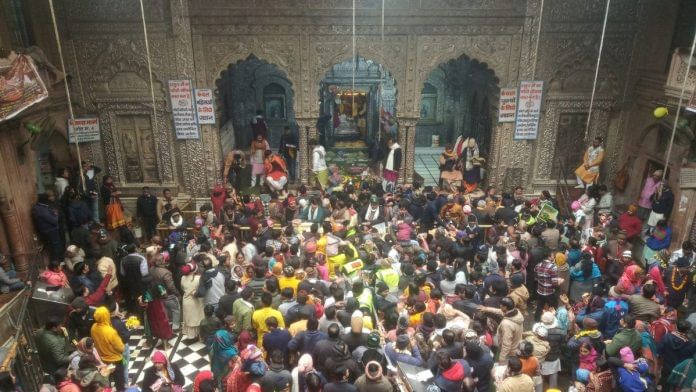Vrindavan: Everyone’s eyes were on the golden gate of the treasure chamber of the Banke Bihari temple in Vrindavan last week. As the decades-old iron locks on the toshkhana were broken using a grinder, there was a collective hush of anticipation — a hope of unearthing hidden treasures.
Torch light pierced the darkness of the toshkhana full of cobwebs and layers of dust. On October 18, days before Diwali, the golden-coloured wooden gate of the toshkhana was opened after 54 years.
What came out was a whimper, not the massive treasure trove of gold that was imagined. After a two-day search, the items found were two copper coins, three silver sticks, and one golden stick with gulal on it.
It surprised Vrindavan residents and officials. The air in the town is thick with conspiracy theories and myths. Finding buried temple wealth is a popular fantasy in India, often peddled with superstitions and fears. Kerala’s Padmanabhaswamy Temple, considered the world’s richest, has been a fascination for many. Five of the temple’s six vaults have been opened, but vault B remains sealed, with devotees believing that the treasure inside is guarded by snakes. Mumbai’s Siddhivinayak is another temple that has received huge amounts of gold in offerings, while the Tirupati temple’s net worth is estimated to be around Rs 3 lakh crore.
In 2015, the government wanted to put temple gold in banks and have them circulate in the economy. That year, Mumbai’s Siddhivinayak temple conducted an auction of the gold coins from its ‘strong room’. According to the World Gold Council, wealthy Hindu temples are repositories for a large part of the $1 trillion privately owned gold in India. Many now fear that the UP government wants to use the temple wealth to build a grand corridor complex in the region.

But the no-show at the Banke Bihari temple last week did not surprise the priest community of the centuries-old temple, the Goswamis.
“Toshkhana was last opened in 1971. The Goswamis already know that there is nothing valuable inside it. All the treasure already shifted to the bank account decades ago. People were surprised about the findings but we are not. There is no secret inside the room,” said Chotu Goswami, priest at the Banke Bihari temple, sitting at his gaddi outside the temple gate.
The hunt for treasure at the 19th-century toshkhana has once again brought Banke Bihari temple to the centre of discussion. As per the directions of a Supreme Court–appointed high-powered committee, the toshkhana — located adjacent to the sanctum sanctorum — was inspected for two days. The Yogi Adityanath government wants to build a grand corridor in Vrindavan along the lines of Varanasi’s Kashi Vishwanath temple corridor and the Mahakal Lok corridor in Ujjain. The government plans to develop five acres of area around the temple by acquiring land from residents, who have been opposing the move for the past three years.
The government has an eye on temple funds. Toshkhana inspection is the latest proof that they want to take over the whole management of the temple
– Chotu Goswami, priest at the Banke Bihari temple
The sudden inspection has riled up the Goswamis who were against the opening of the toshkhana.
“The high-powered committee was constituted to ensure facilities for devotees. It should not interfere elsewhere. By opening the room, what do they want to prove?” said Goswami.
“The government has an eye on temple funds. Toshkhana inspection is the latest proof that they want to take over the whole management of the temple,” he added.
But officials of the Mathura administration said the inspection was carried out in compliance with the apex court’s direction. In August this year, the Supreme Court constituted a 12-member high-powered committee led by retired Allahabad High Court judge Ashok Kumar to oversee the day-to-day functioning of the temple.
The search team included the civil judge, city magistrate, SP city as well as four nominated Goswamis.
“The team inspected the toshkhana for two days. It was challenging for us because the area was locked for decades. Initially, we suffered from suffocation inside the room but the area was then cleaned. We have made a list of the items found and the detailed report will be presented before the committee on October 29,” a member of the inspection team told ThePrint.
A dark room with no secrets
The opening of the gate of the toshkhana was done as per rituals. At the chamber’s entrance, a diya was lit, and a priest bowed to the gate before placing the angle grinder on the lock.
Meanwhile, people kept calling out to him to turn on the grinder. “It was all under the search team’s supervision and all has been videographed,” said Dinesh Goswami, a member of the committee.
He said the procedure to open the toshkhana started around 1 pm and it took several hours. “When it opened, first the area of the basement was cleaned to enter,” he said.

On the first day, the search team inspected the chamber for around four hours. The first major hurdle was unlocking the door, since they did not have the keys to open the locks. The wooden gate of toshkhana was in a bad condition, infested with termites.
The search team was adequately equipped for the inspection. “We also have snake catchers with us as there was suspicion about the presence of snakes inside. Oxygen cylinders were there as the door was locked for decades and a lot of dust was there. Fortunately, we entered safely inside it,” said a member of the team.
When the team stepped inside the toshkhana, they found a tin box with utensils. A small room was also discovered where silver and gold sticks were found in a box.
After a four-hour long search on the first day, the inspection was halted and a lock was placed. The exercise was resumed the next day.
Lakhs of people visit the temple every year and people are donating money. Where has the money gone? We were surprised to see the toshkhana mostly empty. Maybe the Goswamis distributed all the wealth between them already
– Vansh Bhardwaj, who runs a shop near the temple
The last time the Banke Bihari temple toshkhana was opened was in 1971. “The then member of the temple management committee deposited all the valuable items in the State Bank of India. Since then, the toshkhana is completely empty,” said Chotu Goswami.
Chotu Goswami said when the temple was established in 1862, the sevayats of the temple felt the need for a toshkhana to store the temple treasure. “In 1864, toshkhana was built just beneath the sanctum sanctorum. Since then, all the documents, gifts, and money offered to the temple have been kept there till 1971,” said Goswami, adding that earlier the temple got donations from Bharatpur, Karauli, and Gwalior kingdoms.
The toshkhana also witnessed two big thefts during the British period in 1926 and 1936. “After those thefts, the temple committee decided to transfer all the treasury to some other place. After independence, an account was opened in the name of a temple in Mathura and all the collections deposited there,” said Goswami.
Also read: This is how Bihar’s Jeevika didis spent the govt’s Rs 10,000
Conspiracy theories in the air
Besides the sweet aroma of peda and flowers, Vrindavan’s air is filled with conspiracy theories about the toshkhana.
These theories gained momentum just before the inspection started. As per the district magistrate’s order dated October 12, a notice was pasted on the walls of the temple, announcing the opening of the treasure chamber.
Residents, shopkeepers to devotees, all have their own story about the toshkhana. “Lakhs of people visit the temple every year and people are donating money. Where has the money gone? We were surprised to see the toshkhana mostly empty. Maybe the Goswamis distributed all the wealth between them already,” said Vansh Bhardwaj, who runs a shop near the temple.

Bhardwaj recalled the day when the team came to inspect the toshkhana. “We were hoping that khazana will be unearthed. The day was Dhanteras and everyone in Vrindavan hoped for dhanvarsha. But kuch bada nikla nahi (nothing big was unearthed),” Bhardwaj added.
On social media, users came up with satirical posts. “Maal kisi ne pehle hi hazam kar liya (Someone has already made away with the goods)”, read one of the comments on X. Another user said, “Babus and politicians have looted temple wealth more than the invaders could ever do”.
An Instagram page, Vibes of People, which has over 42k followers, used Kishore Kumar’s song Ye kya hua, kaise hua, kab hua to describe the situation. “Where did the gold go?” read the caption.
Local newspapers were filled with news about the toshkhana. “Thakur ji ka maal kahan gaya (Where did Thakurji’s treasure go?)” read one of the headlines. Another said: “Khazana khulte hi utha saval, kaha gya Thakurji ka maal? (As the chamber was opened, a question arose, where did Thakurji’s treasure go?)”
In Vrindavan’s kunj gali near the temple, toshkhana is a hot topic. “Goswamis who serve the temple are very rich here. How did they become rich?. All because of the donations. They eat all the money of Thakurji,” said Rishabh Kumar, who came for darshan at Banke Bihari from Delhi.
Since the day the UP government proposed a corridor in Vrindavan, Goswamis have been opposing it. The government sought to use the temple fund for the development of five acres of land under the project.
In May this year, the UP government passed an ordinance to establish a trust for managing the temple, with the aim to improve administration and facilities. In August, the Supreme Court questioned the government’s haste. The apex court put the ordinance on hold and directed the Allahabad High Court to rule on its validity within a year.
“A humble request to the BJP government… at least leave the treasures of the temples… so much greed is not good,” former UP Chief Minister Akhilesh Yadav posted on X.
The priests of the temple said the government wants to take over the management of the temple completely. “Despite giving facilities to the public, the government stuck only to the corridor. They have an eye on the temple funds,” said Chotu Goswami.
But residents of Vrindavan are demanding an investigation.
“The government should probe the matter under CBI. After all, we should know where the money has gone,” said Radheshyam Mittal, a resident of Vrindavan.
(Edited by Aamaan Alam Khan)







The toshakana was opened in 1971. All the jewels and “khazana” was shifted to the bank, SBI MATHURA branch. The committee head, Ashok Kumar is well aware of it. Please include that as well in the article. It’s not a secret. This article is a bizarre attempt to create bullshit out of thin air. Maybe do little research before printing anything.